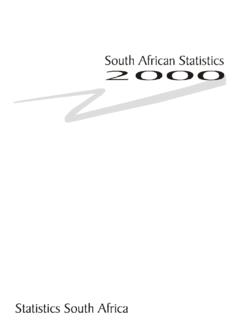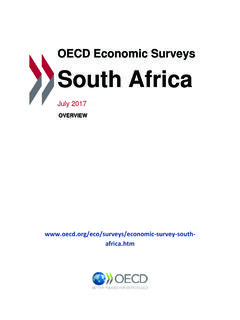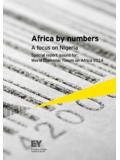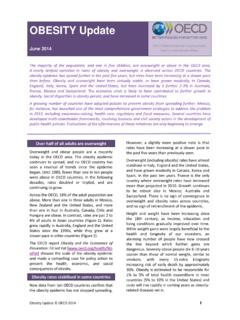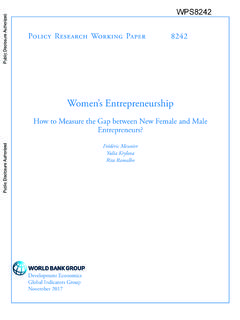Transcription of Producer Price Index - Statistics South Africa
1 Producer Price Index Producer Price Index Methods, Sources and Theory South Africa Producer Price Index 1 Table of Contents Chapter 1: Introduction to the South African PPI .. 2 History of the South African PPI .. 2 Background on Price indices .. 2 Definition of the PPI .. 3 Uses of the 3 Chapter 2: Types of Producer Price indices .. 4 Overview .. 4 Stages-of-production .. 4 Aggregation of the South African PPI .. 4 Chapter 3: Classification .. 6 Background .. 6 The structure of classification of the South African PPI .. 6 Chapter 4: Weighting sources and derivation .. 8 Industry 8 Product weights .. 8 PPI weight selection .. 9 Review of the PPI weights .. 10 Chapter 5: Basket of goods .. 11 Introduction .. 11 Selection criteria for basket of goods .. 11 The number of products in the basket.
2 11 Chapter 6: Sampling .. 12 Introduction .. 12 Selection of businesses (respondents) .. 12 Optimal allocation of items .. 12 Selection of a sampled product from the respondent .. 13 Chapter 7: Data collection and processing (includes editing and data quality evaluation) .. 14 Introduction .. 14 Collection period and frequency .. 14 Type of prices collected .. 15 Processing and data validation .. 15 Chapter 8: Imputations in the PPI .. 16 Chapter 9: Index calculation .. 17 Overview .. 17 Elementary indices .. 17 High-level indices .. 18 Graphical example of the aggregation structure of the PPI .. 19 Linking of the PPI .. 20 Features of a linked Index .. 20 Method of linking the PPI .. 21 Bibliography .. 23 Appendix A: Input and Output CPCs .. 24 Appendix B: Basket of products in the PPI, Price collection methodology and frequencies.
3 27 Statistics South Africa Producer Price Index 2 Chapter 1: Introduction to the South African PPI History of the South African PPI Prior to 2013 , the South African PPI consisted of three parts, namely domestic output of South African industry groups, exported commodities and imported commodities. Domestic output included the value of all products produced within the boundaries of South Africa , irrespective of whether they are exported or used in the domestic market. Imports were not included in this Index . For the Domestic output and Import tables respectively, prices were measured at the first supply phase, by South African producers , and at the first purchasing phase, where the goods enter South Africa . Within the domestic output PPI structure the high-level groups were: v Agriculture, fishing, forestry v Manufacturing v Mining, electricity, gas, steam and water Figure 1: Interrelationships Note: Statistics Sweden interrelationships are used as a guide Background on Price indices Four of the principal Price indices in the system of economic Statistics the PPI, the Consumer Price Index (CPI), and the export and import Price indices are well known and closely watched indicators of macroeconomic performance.
4 They are direct indicators of the purchasing power of money in various types of transactions and other flows involving goods and services. As such, they are also used to deflate nominal measures of goods and services produced, consumed, and traded to provide measures of volumes (IMF PPI Manual). producers selling Price export market producers selling Price domestic market Imports Export commodities Domestic output Import commodities Statistics South Africa Producer Price Index 3 Ten fundamental steps can be defined for the design, construction, dissemination, and maintenance of a Producer Price Index . These steps are (IMF PPI Manual, 2004): 1. Determining the objectives, scope, and conceptual basis of the Index ; 2. Deciding on the Index coverage and classification structure; 3. Deriving the weighting pattern; 4.
5 Designing the sample; 5. Collecting and editing the prices; 6. Adjusting for changes in quality; 7. Calculating the Index ; 8. Disseminating the indices; 9. Maintaining samples of businesses and product specifications; and 10. Reviewing and reweighting the Index . This manual will cover steps one to five, step seven; and steps nine to ten. Definition of the PPI The PPI indicates changes in Producer prices of locally produced commodities including exports. The PPI is defined as A measure of the change in the prices of goods either as they leave their place of production or as they enter the production process (OECD). Uses of the PPI PPIs are used for a variety of different purposes. There has always been substantial interest in, and demand for, Price indices from the general public, private sector as well as government and international agencies.
6 The PPI may be used for purposes of: fi As a short-term indicator of inflationary trends The monthly PPI with detailed product and industry data allows short-term Price inflation to be monitored through different stages of production. fi Contract Price adjustments The purpose of using the PPI for indexing long-term contracts to take the inflationary risk out of the contract. fi A deflator in the compilation of national accounts a fundamental use of the PPI is as a deflator in the national accounts. Therefore, the concepts underlying the PPI are often conditioned by those underlying the national accounts. Statistics South Africa Producer Price Index 4 Chapter 2: Types of Producer Price indices Overview The aggregation of the PPI may take various forms; the South African PPI uses the stages of production approach.
7 With this concept, each commodity is allocated to the stage in which it is used. Alternatives are the stage of processing, net output Price indices per industry, PPI for the country or region, etc. The selection of the aggregation method depends on the intended uses of the PPI. Stages-of-production For this approach each commodity is allocated to the stage in which it is used. A product is included in each stage to which it contributes, and not assigned solely to one stage. The classification of products to the different stages is usually achieved by reference to input-output (I/O) tables in order to avoid multiple counting of the stages that are not aggregated (IMF). This type of PPI has two types of indices, input and output ( Statistics New Zealand). The output Producer Price indices relate to selected products that are primary to a particular industry, irrespective of the industrial classification of establishments undertaking the activity.
8 The input Producer Price indices relate to selected products used by establishments classified to particular industries (ABS). The PPI output indices show changes in prices before the addition of commodity indirect taxes. This is similar to an ex-factory Price or the revenue actually received by a Producer . In the calculation of input indices, the values for commodities purchased generally show changes in prices after the addition of tax ( Statistics New Zealand). Aggregation of the South African PPI When selecting an aggregation type, a number of questions are required to be taken into consideration. The OECD sets the following list as a guideline to the selection of aggregation type: a) Will the PPIs be used for deflation of outputs (and inputs?), and/or as a measure of inflation? b) Assuming that a choice has to be made, are industry PPIs of higher priority than product PPIs or vice versa?
9 C) Which industries and products should be covered? At what level of detail? d) Will separate indices be compiled for export and domestic market prices? e) Which prices are we trying to measure? Producer prices, wholesale prices? f) What will the geographical coverage be? National, regional? Statistics South Africa Producer Price Index 5g) Monthly or quarterly time series? With the analysis of these guidelines, the level of aggregation most suited to the South African PPI, is the stages-of-production approach. The decision rests on the fact that although the PPI is a key inflation indicator, it is also used for deflation of the national accounts. The approach of the PPI gives a value-chain perspective on the level of inputs and outputs, and eliminates double counting. The tables published in the current PPI include industry (divided into input and output) and product information.
10 Industry tables available are: Table 1: Industry tables Industry Input Output Agriculture, forestry and fishing X Mining X Manufacturing1 X X Water, gas and electricity X Appendix A gives the Input and Output 3-digit group CPC for each of the higher-level industries. 1 Manufacturing with be published as final manufactured goods and intermediate manufactured goods . Statistics South Africa Producer Price Index 6 Chapter 3: Classification Background The PPI uses two classification systems, the Central Product Classification (CPC) and Standard Industrial Classification (SIC) systems. As the name suggests, the CPC is used to identify and aggregate products. The CPC is a classification based on the physical characteristics of goods or on the nature of the services rendered. Each type of good or service distinguished in the CPC is defined in such a way that it is normally produced by only one activity as defined in ISIC2.





